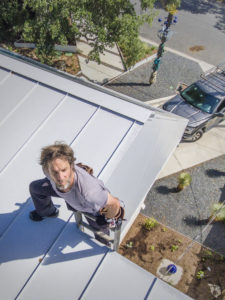eco.inspections®: a visionary home inspection company that approaches each residence as a complex, man-made ecosystem – established in Austin, Texas in 1999.
Owner Roland Huettel applies his expansive building science and construction background to educate and advise clients about the major, inter-related systems at work in the home. He raises the standard set by the Texas Real Estate Commission with an innovative focus on indoor comfort and energy efficiency, including specialized testing.

about Roland Huettel
Born in Munich, Germany, Roland came to Austin in 1993. He instantly clicked with the eclectic culture of Austin, its people, structures, and landscapes. His first Austin home, a historic villa in Travis Heights, fostered his appreciation for the art of wood-framed construction.
In the years that followed, Roland worked as an estimator and supervisor for a local roofing company and developed a passion for educating homeowners about improvements to the safety, comfort and efficiency of their homes.
He studied building sciences to add advanced, theoretical knowledge to his practical construction background. Over the years he became licensed and certified as Building/Electrical/Mechanical and Plumbing Code-Inspector, Heating & Air-Conditioning Contractor, Building Energy Analyst and Commercial Pesticide Applicator.
Roland’s passion and knowledge led to his founding of eco.inspections® in 1999. To date, he has personally inspected over 5,000 homes in the Austin area, ranging from historic homes to modern, architectural gems. When not inspecting, Roland enjoys designing and building indoor & outdoor living spaces inspired by the simplicity and rustic elegance of Japanese Sukiya-style architecture.

 inspections by eco.inspections®
inspections by eco.inspections®
Roland personally conducts each and every inspection for eco.inspections®. He takes his time to get to know each home intimately.
He climbs onto roofs and into attics and crawls underneath floors and around mechanical equipment to test all the major systems in the home. After the inspection, Roland personally meets with clients to explain his findings and prioritize the issues. He takes pride in carefully listening to concerns and thoughtfully answering all questions.



about specialized testing:
A standard, visual inspection (your typical home inspection) cannot measure foundation slopes, view insulation installed in inaccessible areas or measure the amount of conditioned air supplied to the various living spaces. However, foundation settlement, missing insulation and poor duct design + leakage are common problems. Foundation repairs are costly, missing insulation and duct leaks decrease comfort, waste energy, and increase utility bills. Standard, visual inspections cannot detect ducts that are not performing as intended by providing too much or too little air flow to the rooms of the home. Again, this is a common problem not addressed by a standard, visual home inspection.
Roland has continued to push the inspection industry’s boundaries by adding specialized testing of the duct system to the standard inspection process. He uses a “balometer” (air flow meter) to precisely measure and document the air flow supplied by the ducts in all of the homes he inspects, as a bonus to his clients. These measurements allow him to 1) evaluate the duct system design and resulting comfort levels, 2) estimate the supply duct leakage rate and unwanted inefficiencies and 3) make specific and valuable rather than general, boilerplate recommendations.
inspection reports by eco.inspections®
Specific and precise language is an important reporting essential to eliminate guesswork for buyers, sellers, real estate agents, and contractors alike. The use of boilerplate language and checkboxes in standard inspection reports does not tell the full story and can be confusing.
Each eco.inpections® report addresses over 50 separate items (i.e. windows, doors, walls, ducts, dryer vents, etc.) from three different angles:
1) What is installed (the “facts”)? (detailed description of the item – type, location, age, capacity, etc.);
2) How is it functional/deficient (the “defects”)? (detailed explanation of the deficiency, with photos where helpful);
3) Does it maximize comfort and efficiency? (options to improve indoor comfort and energy efficiency, where available).
A summary of defects is included to help realtors write amendments to the contract.
